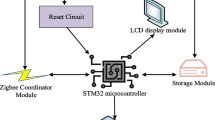Analysis has been made of the methods of improving the energy consumption efficiency of buildings by controlling the heat consumption by various devices (including individual heat points) without and with account for the air temperature control in a room (presence of feedback). Particular consideration was given to the low-cost method of energy saving by decreasing the air temperature in the absence of people, which at present is used inadequately, although its potential can reach 15–20%. The investigations carried out by us have shown that to effectively regulate the energy consumption with the aim of its saving, it is necessary to introduce feedback between the rooms of the building and the individual heat points. Analysis of the thermal state of an old office building with a low energy-efficiency has enabled us to develop methods for decreasing energy consumption by up to 4% for district heating and up to 10% for individual heating.
Similar content being viewed by others
References
Design of heat points, in: Code of Rules on Design and Building SP41-101-95.
Z. Liaoa and A. L. Dexter, A simplified physical model for estimating the average air temperature in multi-zone heating systems, Build. Environ., No. 39, 1013–1022 (2004).
P. G. Krukovskii, O. Yu. Tadlya, M. A. Metel’, and D. I. Sklyarenko, Methodological provision of the method of energy saving at the expense of periodic temperature decrease in the room, Prom. Teplotekh., 36, No. 1, 50–58 (2014).
P. G. Krukovskii, D. I. Sklyarenko, O. Yu. Tadlya, and M. A. Metel’, Determination of heat loss parameters of rooms under nonstationary thermal conditions, Prom. Teplotekh., 35, No. 6, 47–56 (2013).
T. Berthou, R. Stabat, R. Salvazet, and D. Marchio, Optimal control for building heating: an elementary school case study, in: Proc. BS2013: 13th Int. Conf. Building Performance Simulation Association, 26–28 August, 2013, Chambéry, France (2013), pp. 1944–1951.
V. I. Panferov, E. Yu. Anisimova, and A. N. Nagornaya, On optimal control of the thermal regime of a building, Vestn. Uyzhno-Ural'sk. Gos. Univ., Énerg., No. 20, 3–9 (2007).
Realizing savings through the use of controls, in: Building Controls; http://www.carbontrust.com/media/7375/ctv032_building_controls.pdf.
Nest Learning Thermostat; https://nest.com/blog/2011/11/08/teaching-nest-to-save-energy/.
Desi gn of Buildings and Structures, Heat Shielding of a Building, DBN V.2.6-31:2006.
Weather-Dependent Temperature Regulator, Type Promel-TP, Operation Manual; http://www.promelua.kiev.ua/download.html.
V. P. Babak, O. O. Nazarenko, and A. O. Nazarenko, Automatic heat supply control systems: state-of-the-art and prospects, Prom. Teplotekh., No. 6, 38–45 (2014).
Setting-up and Operation of Hot Water Heating Systems: Handbook [in Russian], 3rd enlarged and revised edn., Stroiizdat, Moscow (1988).
P. G. Krukovskii and O. Yu. Tadlya, Identifiability of parameters of the model of thermal conditions of a standard tworoom apartment, Prom. Teplotekh., 28, No. 5, 95–103 (2007).
P. G. Krukovskii, O. Yu. Tadlya, and M. A. Metel', Influence of the power reserve of the heating system on the efficiency of the method of energy saving by decreasing the air temperature in the room, Prom. Teplotekh., No. 2, 76–82 (2009).
Author information
Authors and Affiliations
Corresponding author
Additional information
Translated from Inzhenerno-Fizicheskii Zhurnal, Vol. 90, No. 5, pp. 1307–1315, September–October, 2017.
Rights and permissions
About this article
Cite this article
Krukovskii, P.G., Tadlya, O.Y., Daineko, A.I. et al. Thermophysical Analysis of the Efficiency of Regulating Heat Consumption of a Building. J Eng Phys Thermophy 90, 1243–1250 (2017). https://doi.org/10.1007/s10891-017-1680-0
Received:
Published:
Issue Date:
DOI: https://doi.org/10.1007/s10891-017-1680-0




